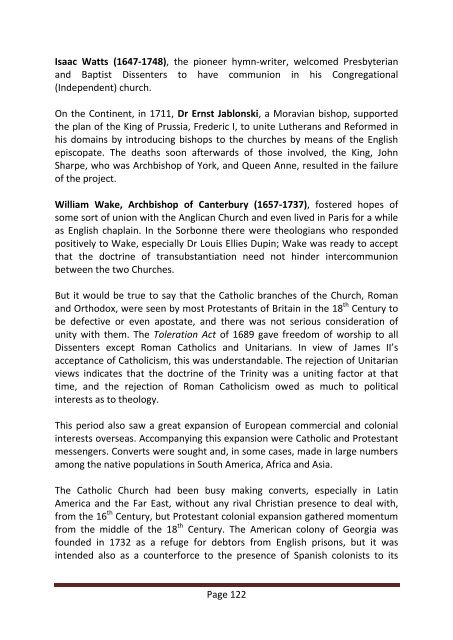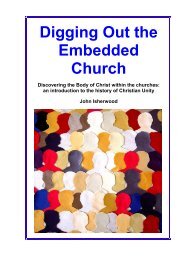Christian Unity (the book) - The Maranatha Community
Christian Unity (the book) - The Maranatha Community
Christian Unity (the book) - The Maranatha Community
You also want an ePaper? Increase the reach of your titles
YUMPU automatically turns print PDFs into web optimized ePapers that Google loves.
Isaac Watts (1647-1748), <strong>the</strong> pioneer hymn-writer, welcomed Presbyterianand Baptist Dissenters to have communion in his Congregational(Independent) church.On <strong>the</strong> Continent, in 1711, Dr Ernst Jablonski, a Moravian bishop, supported<strong>the</strong> plan of <strong>the</strong> King of Prussia, Frederic I, to unite Lu<strong>the</strong>rans and Reformed inhis domains by introducing bishops to <strong>the</strong> churches by means of <strong>the</strong> Englishepiscopate. <strong>The</strong> deaths soon afterwards of those involved, <strong>the</strong> King, JohnSharpe, who was Archbishop of York, and Queen Anne, resulted in <strong>the</strong> failureof <strong>the</strong> project.William Wake, Archbishop of Canterbury (1657-1737), fostered hopes ofsome sort of union with <strong>the</strong> Anglican Church and even lived in Paris for a whileas English chaplain. In <strong>the</strong> Sorbonne <strong>the</strong>re were <strong>the</strong>ologians who respondedpositively to Wake, especially Dr Louis Ellies Dupin; Wake was ready to acceptthat <strong>the</strong> doctrine of transubstantiation need not hinder intercommunionbetween <strong>the</strong> two Churches.But it would be true to say that <strong>the</strong> Catholic branches of <strong>the</strong> Church, Romanand Orthodox, were seen by most Protestants of Britain in <strong>the</strong> 18 th Century tobe defective or even apostate, and <strong>the</strong>re was not serious consideration ofunity with <strong>the</strong>m. <strong>The</strong> Toleration Act of 1689 gave freedom of worship to allDissenters except Roman Catholics and Unitarians. In view of James II’sacceptance of Catholicism, this was understandable. <strong>The</strong> rejection of Unitarianviews indicates that <strong>the</strong> doctrine of <strong>the</strong> Trinity was a uniting factor at thattime, and <strong>the</strong> rejection of Roman Catholicism owed as much to politicalinterests as to <strong>the</strong>ology.This period also saw a great expansion of European commercial and colonialinterests overseas. Accompanying this expansion were Catholic and Protestantmessengers. Converts were sought and, in some cases, made in large numbersamong <strong>the</strong> native populations in South America, Africa and Asia.<strong>The</strong> Catholic Church had been busy making converts, especially in LatinAmerica and <strong>the</strong> Far East, without any rival <strong>Christian</strong> presence to deal with,from <strong>the</strong> 16 th Century, but Protestant colonial expansion ga<strong>the</strong>red momentumfrom <strong>the</strong> middle of <strong>the</strong> 18 th Century. <strong>The</strong> American colony of Georgia wasfounded in 1732 as a refuge for debtors from English prisons, but it wasintended also as a counterforce to <strong>the</strong> presence of Spanish colonists to itsPage 122








